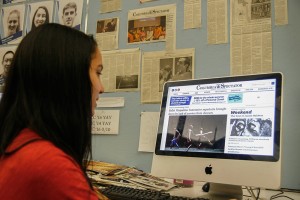EDITOR’S NOTE: Links to selected media news from the past week.
JET GOES ALL-DIGITAL: The African-American magazine made famous for its civil rights coverage will stop printing a weekly publication, instead moving to digital-only content with the exception of an annual “best of Jet” print edition, according to The New York Times.
#ICYMI: JET Magazine stops the presses on print edition http://t.co/6J5vxvZvVb
— HuffPost Chicago (@HuffPostChicago) May 8, 2014
ONE JOURNALIST AND HIS ‘ODDLY COMPELLING’ TWITTER FEED: The Awl’s interview this week with New York Times Tech Columnist Farhad Manjoo digs deep into the thinking behind his feed, recently a mix of tweets about refill policies at Starbucks, the possible future of search engines and his thoughts (many of them) on “tweetstorming.” “I think the person I am on Twitter is the real me. Twitter is the online service that replicates my brain most faithfully,” he told AWL’s Matt Buchanan.

Nicole Santoro, a junior at Columbia University and staff member of the student-run Columbia Daily Spectator, looks at the online edition. Credit: Justin Chan
COLLEGE NEWSPAPERS’ UNCERTAIN FUTURE: Poynter’s Kristen Hare analyzes the state of college media in the wake of The Columbia Daily Spectator’s announcement that it will print once a week. “College newspapers are following students online,” she asks, “but will revenue come along, too?”
RUSSIAN SCRUTINY FOR POPULAR BLOGGERS: A new measure signed by Russian President Vladimir Putin would require any blogger with more than 3,000 hits per day to register with the government and be prepared to certify the factual accuracy of their posts, reports NPR.
LA TIMES GETS A NEW LOOK: The Los Angeles Times rolled out a new web design this week, embracing a mobile news aesthetic with endless scrolling, heavy use of tiles and responsive design to fit a variety of screen sizes — similar to several online-only publications. An ad deal with Etihad Airways has lifted the site’s paywall for the first three days of the redesign, according to Ad Age.
FINANCIAL SUCCESS AT FINANCIAL TIMES: The Financial Times derives 46 percent of its revenue from digital publication, the most of any paper in the UK, and profits from digital revenues cover 75 percent of the paper’s editorial costs. The New York Times only gets 20 percent of its revenue from the digital space. Dorian Benkoil of PBS.org lays out 8 lessons that other media outlets can model for similar success.
THE PAYWALL BLUES: Students who write for the the Columbia Missourian griped this week about the paywall at the paper, which publishes student work under the supervision of professional editors, according to Poynter. “That means that besides shelling out for those credit hours and providing free labor for a professional newspaper, these students have to pay extra money in order for them (and potential employers) to access their own work,” wrote Jill Deutsch in The Maneater, the college’s student newspaper.
DRONE BANS RAISE FIRST AMENDMENT CONCERNS: More than a dozen media organizations filed a brief this week with the National Transportation Safety Board in support of a photographer facing

A drone flies through the 2014 Journalism Interactive Conference in College Park, Md. Credit: Joanna Nurmis
fines for “flying a small drone near the University of Virginia to make a commercial video in October 2011,” reports the Associated Press. According to the brief, media organizations think that federal regulations should also permit drone use among journalists, as newsgathering is a First Amendment right. In other drone news, the U.S. National Park Service recently banned drone use at Yosemite National Park amid concerns that the unmanned vehicles could harm wildlife, according to NBC News.
FREE DOCUMENTARIES FOR ALL: The Docurama Digital Channel plans to offer a free library of more than 1,000 documentaries to about 165 million devices starting May 20. Cinedigm, which provides digital content to a variety of platforms, also hopes to introduce “original programming and festival coverage,” The New York Times reports.
FEEDS TO FOLLOW: TIME.com has put together a comprehensive list of the 140 best Twitter feeds to follow in 2014, complete with celebrities, comedians, athletes and plenty of journalists, including Re/Code’s Mike Isaac on tech, The Atlantic’s Molly Ball on politics and The New York Times’ John Koblin on style.
REWARDING GREAT JOURNALISM (ALL YEAR LONG!): At Nieman Journalism Lab, Raju Narisetti proposes nine ways the Pulitzer Prize Board can promote great journalism throughout the year, including rewarding journalism that had an impact and emphasizing transparency and publicity.
This post includes contributions from Adam Offitzer, Maddie Tallman, Mike King, Lisa Rossi, Dan Appenfeller, Jim Bach, Mary Clare Fischer, Olivia Owens and Kaylin Bugos





Leave a Comment